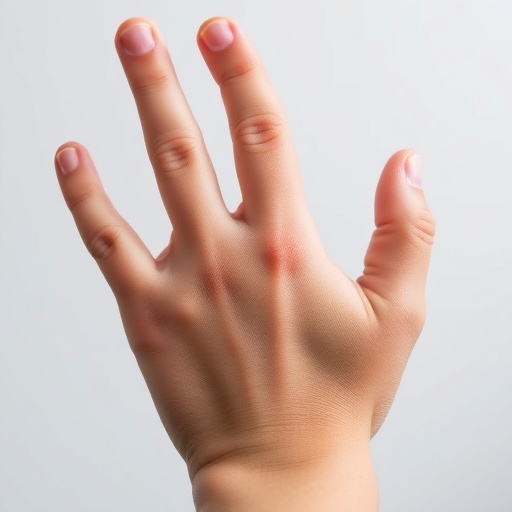In a groundbreaking study soon to be published in the Journal of Child and Adolescent Trauma, researchers have unveiled critical insights into the potential indicators of abuse among young children who present with hand fractures. This research, led by a team of experts in pediatric trauma, highlights not just the physical implications of such injuries but also raises questions about the circumstances leading to them. The findings are particularly significant given that fractures in young children can sometimes be indicative of underlying issues, including neglect or abuse.
The study involved a comprehensive analysis where pediatric patients under the age of seven were rigorously assessed for signs of physical trauma and the context in which these injuries occurred. Hand fractures, particularly among younger children, can frequently suggest scenarios beyond simple accidents. Through in-depth examinations, the researchers sought to distinguish between injuries typically resulting from play and those that could suggest maltreatment.
What sets this research apart is its focus on the subtle signs that often accompany physical fractures. Many times, when a child presents with a fracture, medical professionals focus primarily on healing the physical injury, potentially overlooking the psychological and emotional ramifications. The researchers contend that neglecting to thoroughly assess for signs of potential abuse can lead to repeated cases of trauma, unnoticed by caregivers and professionals alike.
The paper meticulously outlines various demographic and contextual factors that may correlate with higher risks of abuse in children with hand fractures. This includes factors such as the child’s age, the presence of documented family stressors, and the social environment in which the child lives. The researchers argue for an integrated approach that combines medical assessments with social evaluations to create a holistic picture of the child’s well-being.
Moreover, the methodology employed in this study is noteworthy. By examining a comprehensive set of case histories and utilizing advanced statistical analyses, the researchers were able to identify key patterns that correlate with abusive behaviors. This rigorous approach allows for a more nuanced understanding of how hand fractures may fit into a broader narrative of childhood trauma and maltreatment.
An important aspect of the research is its emphasis on training medical professionals to recognize signs of potential abuse. The study advocates for enhanced educational programs that would equip pediatricians and emergency room staff with the tools necessary to identify red flags during examinations. By improving awareness and training, the researchers hope to foster a proactive stance in the identification and prevention of child abuse.
The implications of this study extend beyond individual cases; they may influence policies and practices surrounding child welfare and protection. By making medical professionals more aware of the potential signs of abuse, the research aims to contribute to a systemic change in how child trauma cases are handled. The team hopes that the findings will encourage further interdisciplinary collaboration between healthcare providers and social services, leading to more comprehensive care for vulnerable children.
In addition to healthcare practice, there is a significant call to action regarding public awareness. Society plays a crucial role in recognizing the signs of abuse, and the study reinforces the idea that community education is imperative. Raising awareness about the potential signs of child maltreatment can empower individuals to act when they suspect abuse, bridging the gap between the identification of injury and necessary intervention.
As this research gains attention, it may very well lead to a reevaluation of how society views children’s injuries. The common perception that accidents alone account for physical injuries in children is being challenged. Instead, this study encourages a broader conversation about the factors contributing to childhood trauma and the various layers of complexity inherent in these situations.
Unfortunately, the stigmatization of abuse often leads to underreporting and a lack of intervention when it is most needed. The research findings serve as a critical reminder that vigilance, education, and proactive measures are necessary to protect children from harm. The tragedy of abuse often lies in its invisible nature, making it all the more vital to develop a keen eye for the signs that might otherwise go unnoticed.
Looking forward, the researchers express hope that their findings will lead to substantial advancements in preventive strategies. They envision a future where proactive measures, informed by their research, create safer environments for children. By fostering a culture that prioritizes child safety, healthcare providers, families, and communities can work synergistically to mitigate risks and enhance protective factors.
As the study prepares for publication, experts anticipate that its impact will resonate within the fields of pediatrics, child psychology, and social work. By addressing the often-taboo subject of child abuse head-on, the researchers are laying the groundwork for not only better identification of abuse but also effective interventions and support systems.
In conclusion, Ben Natan, Maman, and Berkovich’s study offers a vital lens through which to view and understand the complexities surrounding hand fractures in young children. By pushing for heightened awareness and integrative practices, the implications of their work extend far beyond the walls of medical facilities, encouraging a collective effort to safeguard the well-being of children in our communities.
Subject of Research: Potential Abuse in Young Children with Hand Fractures
Article Title: Identification of Potential Abuse in Young Children with a Hand Fracture
Article References:
Ben Natan, M., Maman, D. & Berkovich, Y. Identification of Potential Abuse in Young Children with a Hand Fracture.
Journ Child Adol Trauma (2025). https://doi.org/10.1007/s40653-025-00750-w
Image Credits: AI Generated
DOI: 10.1007/s40653-025-00750-w
Keywords: child abuse, hand fractures, pediatric trauma, child maltreatment, medical assessment, prevention strategies.




